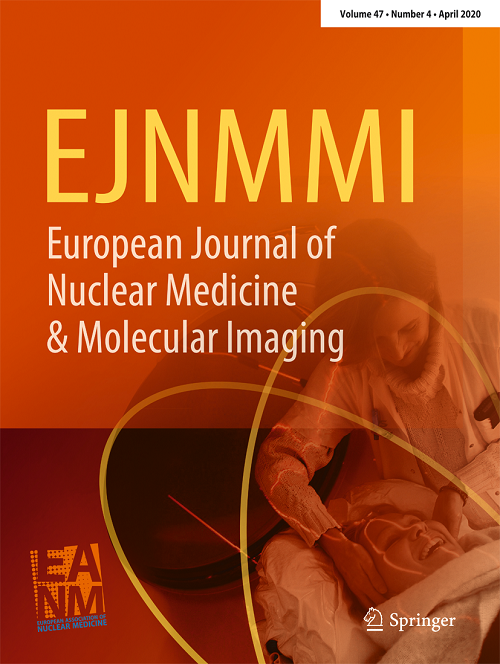利用人工智能在衰减校正计算机断层扫描上测量冠状动脉钙:与冠状动脉血流容量和预后的相关性。
IF 7.6
1区 医学
Q1 RADIOLOGY, NUCLEAR MEDICINE & MEDICAL IMAGING
European Journal of Nuclear Medicine and Molecular Imaging
Pub Date : 2024-10-15
DOI:10.1007/s00259-024-06948-8
引用次数: 0
摘要
材料和方法 我们回顾性地纳入了 2021 年 9 月至 2023 年 5 月期间接受[13N]氨正电子发射断层扫描(PET)的患者。我们获得了所有患者的 CTac 数据。此外,还评估了有急性冠状动脉综合征(病史)、既往冠状动脉支架植入或搭桥手术或左心室射血分数 90 天)血运重建的患者。研究发现,AI-CACac 与压力 MBF 之间存在显著负相关(ρ = -0.363,p 10),CFC 受损(31% vs. 7%,p < 0.001)和严重缺血(20% vs. 7%)的发生率明显更高,调整其他风险因素后仍有显著相关性。49例(17%)患者发生了MACE(中位随访284天),发生MACE的患者的AI-CACac明显更高(中位数为166对56;P = 0.039)。结论AI 测量的 CACac 与 PET 测量的 MBF 和 CFC 有很好的相关性,但其预后意义还需要进一步验证。本文章由计算机程序翻译,如有差异,请以英文原文为准。
Coronary artery calcium measurement on attenuation correction computed tomography using artificial intelligence: correlation with coronary flow capacity and prognosis.
PURPOSE
This study aimed to test whether the coronary artery calcium (CAC) burden on attenuation correction computed tomography (CTac), measured using artificial intelligence (AI-CACac), correlates with coronary flow capacity (CFC) and prognosis.
MATERIALS AND METHODS
We retrospectively enrolled patients who underwent [13N]ammonia positron emission tomography (PET) between September 2021 and May 2023. CTac data were obtained from all the patients. Patients with (history of) acute coronary syndrome, previous coronary stent insertion or bypass surgery, or left ventricular ejection fraction < 40% were excluded. The total Agatston score measured using a dedicated AI-CAC quantification software on CTac was defined as AI-CACac. The correlations between AI-CACac and PET-measured myocardial blood flow (MBF) and CFC and significant ischaemia (summed difference score ≥ 7) were analysed. Their prognostic values for major cardiovascular events (MACE), including death, nonfatal myocardial infarction, hospitalisation due to angina pectoris or heart failure, and late (> 90 days) revascularisation, were also evaluated.
RESULTS
In total, 289 patients were included in this study. Significant negative correlations were found between AI-CACac and stress MBF (ρ = -0.363, p < 0.001) and MFR (ρ = -0.305, p < 0.001). AI-CACac > 10 was associated with a significantly higher prevalence of impaired CFC (31% vs. 7%, p < 0.001) and significant ischaemia (20% vs. 7%), which remained significant after adjusting for other risk factors. MACE occurred in 49 (17%) patients (median follow-up, 284 days), and those who experienced MACE had significantly higher AI-CACac (median, 166 vs. 56; p = 0.039). However, multivariable analysis revealed an independent prognostic association among impaired CFC, diabetes, smoking, but not for AI-CACac.
CONCLUSION
AI-measured CACac correlates well with PET-measured MBF and CFC, but its prognostic significance requires further validation.
求助全文
通过发布文献求助,成功后即可免费获取论文全文。
去求助
来源期刊
CiteScore
15.60
自引率
9.90%
发文量
392
审稿时长
3 months
期刊介绍:
The European Journal of Nuclear Medicine and Molecular Imaging serves as a platform for the exchange of clinical and scientific information within nuclear medicine and related professions. It welcomes international submissions from professionals involved in the functional, metabolic, and molecular investigation of diseases. The journal's coverage spans physics, dosimetry, radiation biology, radiochemistry, and pharmacy, providing high-quality peer review by experts in the field. Known for highly cited and downloaded articles, it ensures global visibility for research work and is part of the EJNMMI journal family.

 求助内容:
求助内容: 应助结果提醒方式:
应助结果提醒方式:


